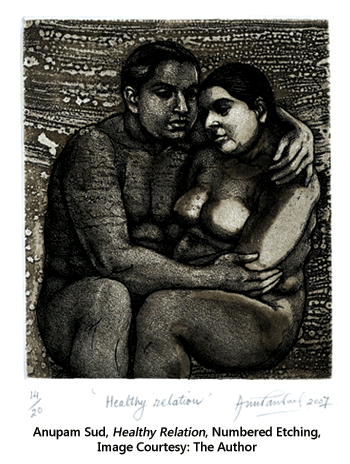A Note on Prints, Reproductions and Editions
Concluding Essay
Waswo X. Waswo
Of late there has been much confusion as to what constitutes a print and what constitutes a reproduction, and astute collectors ought to be aware of the differences. Some of this confusion has been caused by the ramifications of digital technology, whereas most has been caused by ill-informed and/or unscrupulous marketing schemes. Prints that have value are most often prints that have had a high degree of personal input from the artist,  such as woodcuts that have been hand-carved and printed by the artist, or etchings produced with a plate the artist has personally hand-worked and pressed. Such "original artist prints", as they are called, are produced by the artist explicitly and solely to exist in the medium of printmaking.
such as woodcuts that have been hand-carved and printed by the artist, or etchings produced with a plate the artist has personally hand-worked and pressed. Such "original artist prints", as they are called, are produced by the artist explicitly and solely to exist in the medium of printmaking.
Printed reproductions, on the other hand, are generally photo-mechanical or digital recreations of images that exist in a prior form...say, as an oil painting or a drawing. Artists are seldom involved in the physical making of reproductions. Rather, the task is jobbed-out to technicians who copy the pre-existing work with varying degrees of skill. Certainly old etchings and aquatints made by highly-skilled technicians as copies of paintings have now become collector's items, but modern-day reproductions (most often done digitally) generally have no real value (though some dealers may wish to convince you otherwise). A photo-mechanical reproduction may fulfill a niche market of indiscriminating buyers, but, even though such reproductions may be "signed and numbered", they seldom hold value or appreciate.
To put is precisely, original artist prints are the culmination of a creative exercise undertook by the artist in the very process of making the print. A printed reproduction is a copy of a creative work that has a prior marketable existence in a different medium. I am sure these definitions might cause some quibbling; nonetheless, they serve a purpose as a general guide.
Of late there has been the particularly disturbing development of digital reproductions being marketed as "serigraphs"...serigraph being another word for silkscreen. A good eye can detect the difference, with the serigraph generally putting down a far thicker layer of ink than a digital print. Reproduction by serigraph is more difficult, time-consuming, and craft-oriented, causing a reproduction by serigraphy to be more valuable than a reproduction through digital photography. But only serigraphs produced by artists as a specific creative exercise have the possibility to be valued as original artist prints.
Original artist prints are limited to an edition, with a fraction such as 5/30 marked below the image to indicate the edition size. The bottom number states the number of prints in the edition, and the top indicates the number the particular print has been given in the series. So in the preceding example, a print numbered 5/30 would tell you that there are 30 prints in the edition, and that the one you are looking at is number 5 in the series. This all sounds well and good,  but one must be aware of several loopholes, one of which is the Artist Proof.
but one must be aware of several loopholes, one of which is the Artist Proof.
Traditionally an "A/P" has been limited to a small fraction of the stated edition. Many novice collectors make the mistake of thinking a print signed "Artist's Proof" means that it has been "approved by the artist". In olden times this was actually often correct. The signifier "A/P" (artist's proof) was added to the first good print taken from a press. This "master" print was then used as the template from which all further prints in the edition were matched for quality. Artists often kept A/Ps for themselves, and thus they came to be seen by collectors as a desirable item to possess. Unfortunately, in modern times (especially it seems here in India) the "A/P" has been used as a loophole. Knowing the desirability of the A/P, artists have been tempted to create far more Artist Proofs than what has been traditionally accepted. In fact they have at times created series with each print individually labelled "A/P" and no numbered edition at all! Add to this the designation "H/C" ("Hors de Commerce", meaning a print that is generally gifted and not for sale), "second editions" (which ethically ought to be marked as such) and the true number of any given print might far exceed the denominator of the fraction marked in its lower left-hand corner! But it is also good to remember that many prints disappear from circulation through neglect, damage and loss. So it is equally possible that the actual number of existing prints may actually be less than the stated edition size.
Ethical printmakers keep a strict limit to editions and do not abuse the "A/P loophole", and I would say such printmakers create a reputation that in the end makes their work more valuable. Conversely, some printmakers feel that to artificially limit the number of prints produced "before the plate wears thin" is just a marketing strategy. I've nothing against open-edition printmaking by an artist, and in fact some of my most prized prints (such as Chittaprosad's) are just that. But to claim a limited edition and then to not adhere to that is plainly unethical. In making a limited edition the proper practice is for the printmaker to "cross out" or otherwise destroy the plate, woodblock, etc when finished.
In the final analysis original prints (not reproductions) are valued for their imagery, quality, cultural association, historical relevance, prestige of the artist, and scarcity...or any combination of these. It is up to the collector to discern that value.
Tags: art






